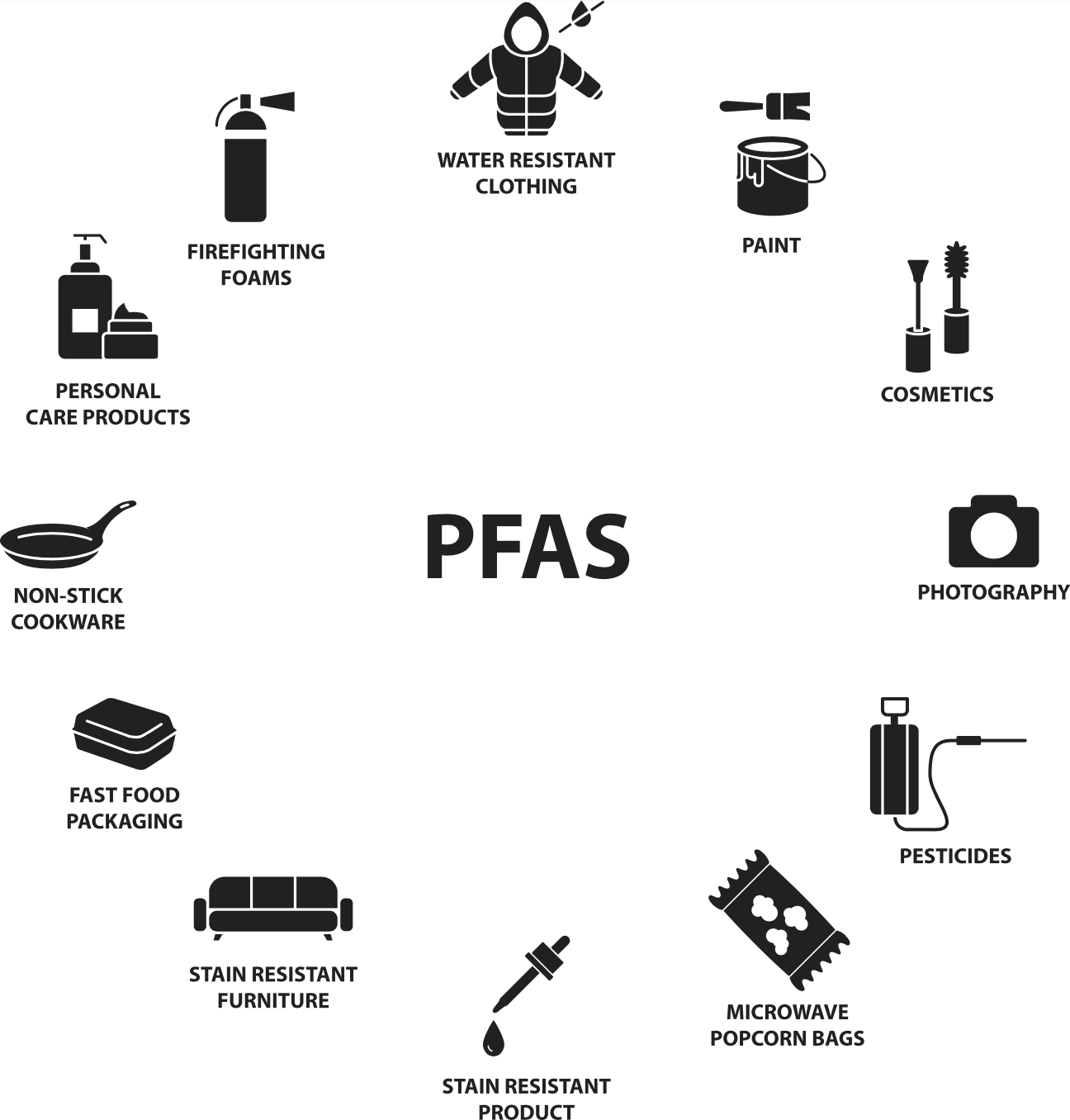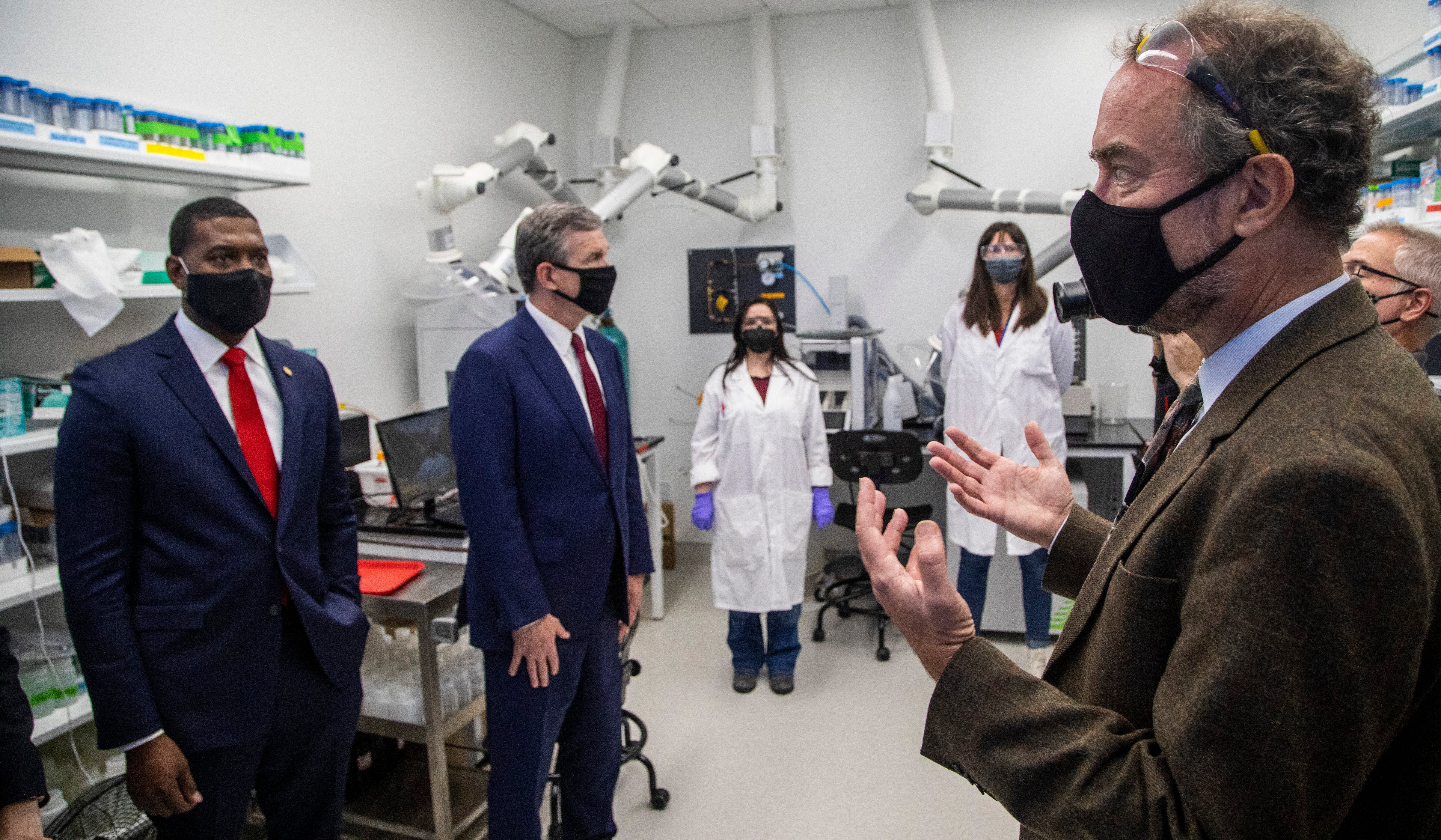Even the name makes the problem seem intractable: “forever chemicals.” This group of per- and polyfluoroalkyl substances, broadly called PFAS, are persistent organic pollutants that don’t readily degrade and can affect human health, with links to liver problems, infertility, thyroid disruption, birth defects, hypertension, and many other harmful effects. They’re in our water, clothes, food, dust — even in umbilical cord blood — and there may be no safe level of exposure. Can anything be done?
Where Are They Found?

“Oh my goodness — they are found everywhere, pretty much,” said Cheryl Murphy, director of the Centre for PFAS Research at Michigan State University. The evidence certainly backs up her claim: The Agency for Toxic Substances and Disease Registry (ATSDR) says that a majority of people in the U.S have PFAS in their blood.
Murphy explained that the most concerning contamination has been found near Air Force bases and airports. This is because PFAS is used in firefighting foams, which she considers the largest release to the environment. What often happens, Murphy noted, is that these locations will contaminate the local drinking water source. People living near those sites will then be exposed through their tap water.
A lesser known source is through something called biosolids, chemically treated sewage sludge that, when meeting federal and state requirements, can be applied to agricultural land.

“A lot of wastewater treatment plants used to sell their biosolids to farmlands as a greener way of fertilizing their crops, but it wasn’t,” Murphy said. “A lot of the biosolids have these PFAS contaminants in them. They’ve been applied to crops, which then goes to crop lands, which then goes up into our food supply.”
Then there are the many other exposures. ATSDR and the EPA list many potential sources: drinking contaminated water, eating seafood from water contaminated by PFAS, accidentally swallowing contaminated soil or dust, and eating food that was packaged in materials with PFAS. Products that may contain PFAS include takeout food containers, candy wrappers, fast food wrappers, nonstick cookware, dental floss, shampoos, cosmetics, anti-fog sprays, water- and stain-resistant fabrics, and so much more. Companies love to use these chemicals because of their ability to repel water and grease.
What Can Be Done?
There’s not much any one person can do, but that doesn’t mean the fight is hopeless.
Lawsuits against corporations that use PFAS may spur change. A Bloomberg Law analysis found there were more than 6,400 PFAS-related lawsuits filed in federal courts in between July 2005 and March 2022. References in pop culture, like the Mark Ruffalo movie Dark Waters, also bring attention to the issue.
According to the ATSDR, since 2002, production and use of PFOS and PFOAS, two common kinds of PFAS, have declined. And from 1999 to 2014, the levels of these substances detected in human blood declined by more than 80% and 60%, respectively, as the use of those chemicals is slowly phased out by U.S manufacturers. But the next concern is what these companies may be replacing them with, as the alternate substances could be just as harmful.
In April 2022, the EPA announced three actions: One could allow authorities to reduce PFAS discharge in our water from the source (the polluter); another will examine the effect of PFAS on aquatic organisms; and the last would draft a new method to screen for PFAS in water samples. The agency is developing a national PFAS testing strategy as part of the PFAS Strategic Roadmap.
“People on the front-lines of PFAS contamination have suffered for far too long. That’s why EPA is taking aggressive action as part of a whole-of-government approach to prevent these chemicals from entering the environment and to help protect concerned families from this pervasive challenge,” said EPA Administrator Michael S. Regan in a press release on June 15. “Thanks to President Biden’s Bipartisan Infrastructure Law, we are also investing $US1 ($1) billion to reduce PFAS and other emerging contaminants in drinking water.”
A health advisory released on June 15 set the permissible health thresholds for PFOS and PFOAS to near zero, which replaced the previous permissible threshold of 70 part per trillion that was set in 2016. The EPA also announced that it is inviting states to apply for $US1 ($1) billion (under the Bipartisan Infrastructure Law) to address PFAS and other contaminants in drinking water.

State agencies can create their own bans and legislations regarding the handling of PFAS. New York has moved to ban PFAS in clothing by 2024. Other states, including Connecticut and California, have adopted laws that would ban PFAS in food packaging.
In another step to address PFOS and PFOAS, the EPA has proposed to designate the two chemicals as hazardous substances under the Comprehensive Environmental Response, Compensation, and Liability Act. If put into place, transparency on the release of these chemicals should increase, as certain releases would have to be reported to the EPA’s National Response Centre, ideally encouraging better waste management and treatment by facilities. This proposal would also hold polluters accountable by, in some cases, making them pay for cleanup costs.
Current Research on PFAS
A July 2022 report found that our current and future technologies could improve the treatment and detection of PFAS in our environment and further our knowledge of how PFAS affects human health. This report, made by U.S Government Accountability Office (GAO), assessed several technologies and the challenges they face in managing PFAS.
For example, mitigation of PFAS involves removing PFAS-contaminated materials, which is different than removing PFAS from water, a process that uses specific filtration systems. The contaminated materials are either dumped in landfills or destroyed through incineration. However, this treatment may bring its own problems.
In a well-monitored, maintained, and modern landfill, the PFAS should stay within the landfill, according to Karen L. Howard, director of GAO’s Science, Technology Assessment, and Analytics team.
“But since PFAS are resistant to natural degradation and have been produced for decades in a large range of products that may end up in landfills, some closed landfills may be leaking PFAS into the environment via leachate or landfill gas,” Howard wrote in an email to Gizmodo. “Since there is no finalised, published method for detecting PFAS in leachate, it is difficult to say with certainty how widespread the problem is.” Leachate is a liquid that has passed through solids, commonly picking up contaminants along the way.
GAO, as part of this assessment, developed policy options for lawmakers at the federal and local levels, like supporting full-scale treatment, which could help address the obstacle of cost and efficiency of current and new technologies, and also address lack of guidance from regulators.
Other research on PFAS includes the possibility of using microbes to break down PFAS. Researchers found that when the carbon-fluorine bond in this specific PFAS class is broken, it could be possible to remove the fluorine using microorganisms. While it may not completely degrade the molecule, experiments like this could bring us closer to a solution.
“Currently, biocatalysts that can do defluorination of perfluorinated compounds like PFOA are very rare. We still know very little about which microbes or enzymes can do the defluorination of PFAS in general and how,” Yujie Men, a researcher on the study, said in a release from the University of California, Riverside. “Our work is at the leading edge of finding this information.”
OK, but how can I avoid them?
Men told Gizmodo that she conducts her own “research” when she is out buying products. “For consumers, we can do nothing for PFAS treatment, but at home we can keep PFAS out of our lives as much as possible. We can try to use PFAS-free products. There is a website [pfascenetral.org] which lists different brands that claim to use PFAS-free material,” Men said.
The website Men mentioned lists various companies that claim to be PFAS free. To have their name on the website, companies must have publicly stated that their product is made without the intentional use of PFAS or have been tested and proved to be PFAS free; a majority of companies on the list simply have policies stating they have phased out PFAS.
For other worries, like for drinking water, Men said you should consider using a water purification system with reverse osmosis under the sink, as “those systems can eliminate/reject PFAS molecules.” Certain countertop water purifiers like AquaTru Classic and RKIN Countertop purifier (for PFOA/PFOS) are among the filters that can be used against PFAS.
Murphy emphasised that individual action for a problem as big as PFAS is not the answer. We need to change the production of it and find safer alternatives, as well as stop mass producing these chemicals without proper cleanup. But the most important thing Murphy wants people to know is that this chemical can’t be ignored.
“I think public awareness is key, because if people don’t know about it, then it won’t get changed. This is a global contaminant. It’s a global problem,” Murphy said. “So it’s going to need a lot of awareness and a lot of people wanting to change things.”
Editor’s Note: Release dates within this article are based in the U.S., but will be updated with local Australian dates as soon as we know more.
